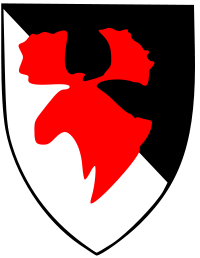11th Infantry Division (Wehrmacht)
The 11th Infantry Division (11. Infanterie-Division) was a formation of Nazi Germany's Wehrmacht during World War II. Formed 1 October 1934 as Infanterieführer I in Allenstein it was renamed 11. Infanterie-Division on 15. October 1935 with the disclosure of German rearmament.
| German 11th Infantry Division 11. Infanterie-Division | |
|---|---|
 | |
| Active | 1 October 1934 – 8 May 1945 |
| Country | |
| Branch | Army |
| Type | Infantry |
| Size | Division |
| Garrison/HQ | Allenstein |
About two-third of the division could be evacuated to Schleswig-Holstein from the Courland pocket on 30 April 1945. Commander Feyerabend and the rest of the Division went into Russian captivity.
Commanders
- Generalleutnant Günther von Niebelschütz : 1 October 1934 – 1 April 1937
- Generalleutnant Max Bock : 1 April 1937 – 23 October 1939
- Generalleutnant Herbert von Böckmann : 23 October 1939 – 26 January 1942
- Generalleutnant Siegfried Thomaschki : 26 January 1942 – 7 September 1943
- Generalleutnant Karl Burdach : 7 September 1943 – 1 April 1944
- Generalleutnant Hellmuth Reymann : 1 April 1944 - 18 November 1944
- Generalmajor Gerhard Feyerabend : 18 November 1944 - 8 May 1945
Subordination and deployment
| Timeframe | Army Corps | Army | Army group | Location |
|---|---|---|---|---|
| September 1939 | I | 3. Armee | North | East Prussia, Poland |
| December 1939 | Reserve | B | Lower Rhine | |
| January 1940 | 6. Armee | Lower Rhine, Belgium, Lille | ||
| June 1940 | I | 4. Armee | Somme, Loire | |
| July 1940 | 7. Armee | Atlantic coast | ||
| September 1940 | Reserve | |||
| November 1940 | XXXI | D | ||
| March 1941 | Reserve | 18. Armee | B | East Prussia |
| April 1941 | I | |||
| May 1941 | C | |||
| June 1941 | North | East Prussia – Wolchow (Volkhov River) | ||
| September 1941 | 16. Armee | Wolchow – Ladoga | ||
| December 1941 | 18. Armee | |||
| May 1942 | XXVIII | |||
| February 1943 | XXVI | |||
| October 1943 | LIV | Leningrad | ||
| February 1944 | L | Pleskau (Pskov) | ||
| March 1944 | XXVI | Army Detachment "Narwa" | Narva | |
| June 1944 | XXXXIII | |||
| July 1944 | III. SS | Narva, Pernau (Pärnu), Riga | ||
| October 1944 | I | 18. Armee | Courland | |
| December 1944 | X | |||
| January 1945 | I | |||
| February 1945 | II | Kurland | ||
| March 1945 | L |
Literature
- Burkhard Müller-Hillebrand: Das Heer 1933–1945. Entwicklung des organisatorischen Aufbaues. Vol.III: Der Zweifrontenkrieg. Das Heer vom Beginn des Feldzuges gegen die Sowjetunion bis zum Kriegsende. Mittler: Frankfurt am Main 1969, p. 285.
- Georg Tessin: Verbände und Truppen der deutschen Wehrmacht und Waffen-SS im Zweiten Weltkrieg, 1939 – 1945. Vol. III: Die Landstreitkräfte 6 – 14. Mittler: Frankfurt am Main 1967.
gollark: So if you're in a room entirely filled with nitrogen or some other inert gas, you'll just die without realizing why!
gollark: Interestingly, human out-of-breath detection works by sensing excess CO2, not low oxygen.
gollark: These are moderately good!
gollark: Indeed. That's why I made the Macron style guide.
gollark: I might use the CLIP scoring thing.
This article is issued from Wikipedia. The text is licensed under Creative Commons - Attribution - Sharealike. Additional terms may apply for the media files.